Social media stories dominated the list of most popular marketing charts and articles in MarketingProfs in 2010.* Facebook, Twitter, LinkedIn, or Wikipedia, figured prominently in seven of the Top 10 articles, which also covered subjects such as email, mobile, marketing budgets, and content marketing.
1. Facebook Users Like Brands for Discounts, Social Badging
Why do consumer "like" brands? ExactTarget and Co-Tweet answer the question: Although consumers turn to Facebook primarily to connect with friends and fill downtime, product discounts and "social badging" are the most commonly cited motivations for "liking" brands on Facebook, according to a survey released in September 2010.
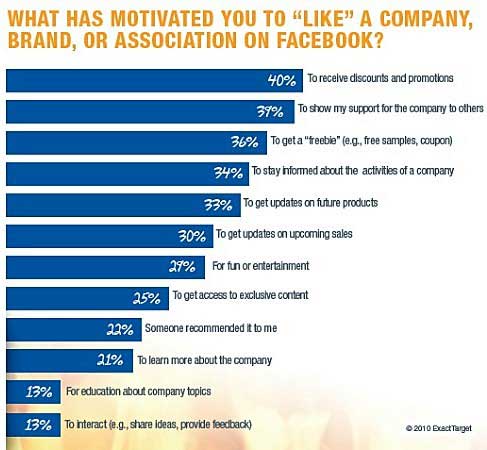
Over two in five surveyed Facebook users (43%) say they "like," or are fans of, at least one brand on Facebook. Among them, 40% say they like brands to receive discounts and promotions, whereas 39% say they do so to publicly display their brand affiliations to others. By contrast, 23% of consumers who follow brands on Twitter do so for social-badging purposes.
For additional charts and findings, see "Facebook Users Like Brands for Discounts, Social Badging."
2. Mobile Ad Campaigns Are More Effective Than Online
So 2010 became the year that mobile was officially given a seat at the adult table. In this study from April, InsightExpress noted that mobile campaigns are emerging as powerful ad channel for marketers, outperforming online advertising by nearly five times across a variety of metrics, including unaided awareness, message association, and brand favorability.
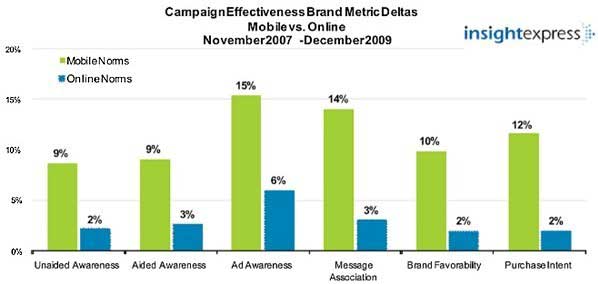
Benchmarked against performance norms developed for online advertising, mobile campaign norms were also 6.0 times higher than online campaign norms in purchase intent, 3.0 times higher in aided awareness, and 2.5 times higher in ad awareness.
For additional charts and findings, see "Mobile Ad Campaigns Are More Effective Than Online."
3. Email Metrics: Open and Click Rates Decline
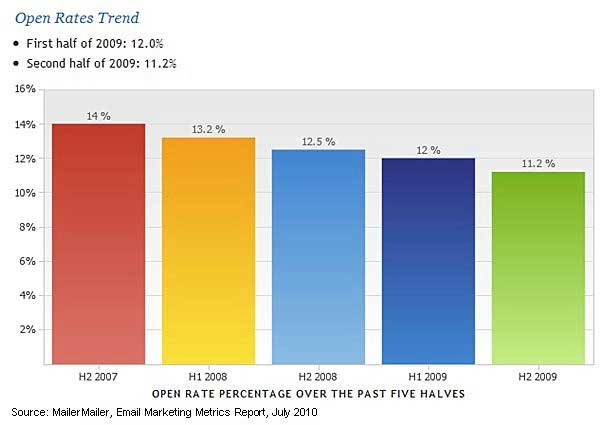
Email open and click-through rates declined sharply in 2009, especially in the latter half of the year, with performance levels varying dramatically by industry and email list size, according to a study released in July by MailerMailer. If you want to increase your email’s performance, however, consider a weekend mail: The study found that open and click rates tended to be highest on Sundays.
For additional charts and findings, see "Email Metrics: Open and Click Rates Decline."
4. Marketing Execs Dish on Budgets, Social Media, and Favorite Gurus, Brands, Publications
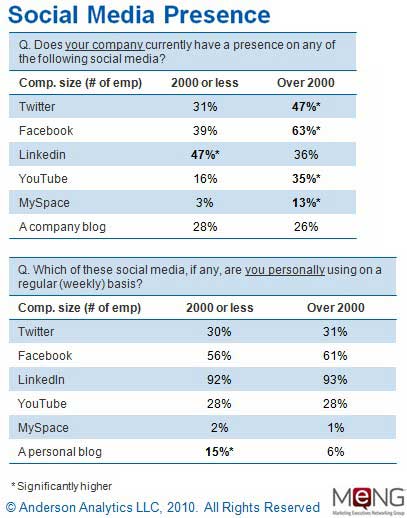
Guess who was the prettiest girl at the Marketing Ball in 2010? Social media is an essential marketing tool that most companies are readily embracing, according to a March study by the Marketing Executives Networking Group (MENG) and Anderson Analytics. The study found that 70% of senior marketing executives surveyed are planning new social media initiatives during the year.
For additional charts and findings, see "Marketing Execs Dish on Budgets, Social Media, and Favorite Gurus, Brands, Publications."
5. LinkedIn Delivers B2B Traffic, Wikipedia More Leads
LinkedIn was a strong leader in this story, but Wikipedia? Seriously? I know. Weird. Anyway, this LeadForce1 study from June said that among social media channels, LinkedIn accounts for the greatest number of referred visitors to B2B websites. But Wikipedia is more effective at delivering relevant and serious leads.
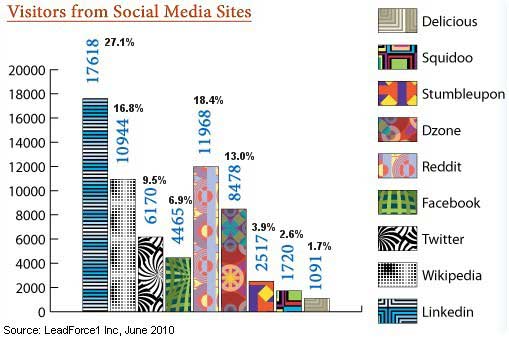
In addition, visitors referred to B2B websites from Wikipedia spend more time on those sites once they arrive—3.22 minutes on average—compared with visitors from Facebook (2.53 min.), LinkedIn (2.50 min.), and Twitter (2.46 min).
For additional charts and findings, see "LinkedIn Delivers B2B Traffic, Wikipedia More Leads."
Looking for real, hard data that can help you match social media tools and tactics to your marketing goals? The State of Social Media Marketing, a 240-page original research report from MarketingProfs, gives you the inside scoop on how 5,140 marketing pros are using social media to create winning campaigns, measure ROI, and reach audiences in new and exciting ways.
6. Companies Using Social Media Without Game Plan
Under "circumventing the globe without a navigational system" comes the story that, despite widespread adoption of social media marketing, most companies are without a plan. Most are still learning how to integrate those efforts into their overall corporate strategies: 78% of surveyed companies say they actively use social media, but just 41% say those efforts are part of a strategic game plan, according to a June survey from Digital Brand Expressions (DBE).
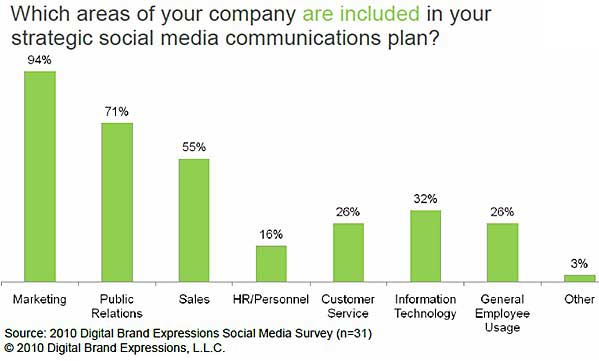
Overall, the survey showed that Marketing is in charge of social media: 71% of companies that do work from a strategic plan say the marketing department has primary responsibility for creating and maintaining the firm's social media presence; 29% cite communication departments, and 16% cite the executive team.
For additional findings, see "Companies Using Social Media Without Game Plan."
7. CMOs to Ramp Up Hiring, Budgets; Double Social Media Spend
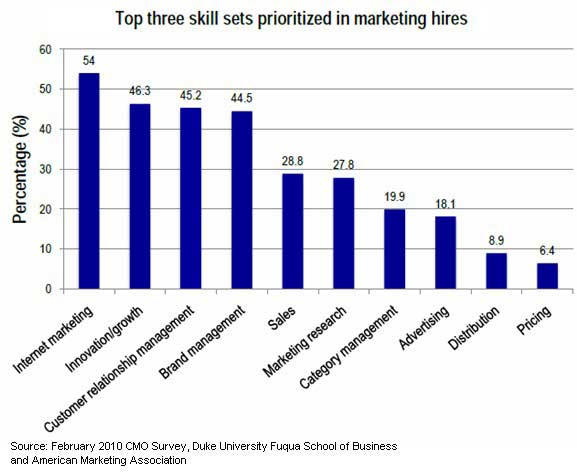
Chief marketing officers at US companies in March appeared to be an optimistic bunch: Many were planning significant hiring and budget increases over the next two years, according to a survey conducted by Duke University and the American Marketing Association. Overall, CMOs expect marketing budgets to increase, on average, 5.9% in the next year, with social media emerging as a central component of Internet marketing strategies.
For additional charts and findings, see "CMOs to Ramp Up Hiring, Budgets; Double Social Media Spend."
8. Email, Facebook, Twitter: How Users Engage With Brands
More evidence that email is the social glue comes from this ExactTarget study, released in July: More than 90% of consumers who are a fan of, or "like," at least one brand on Facebook also receive at least one permission-based marketing email per day, and roughly 75% of consumers who follow at least one brand on Twitter subscribe to at least one brand's email marketing.
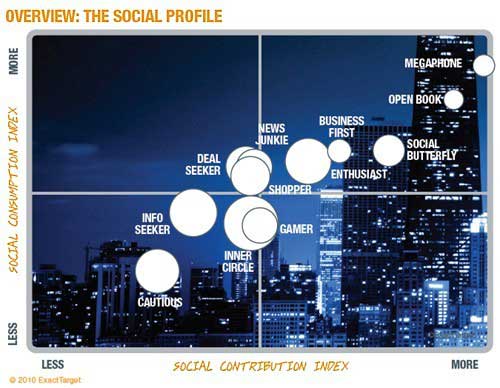
Many among such consumers are Social Butterflies, one of 12 distinct online personas that describe online motivations.
For additional charts and findings, see "Email, Facebook, Twitter: How Users Engage With Brands."
9. Fortune 500 Social Media Use: Twitter Overtakes Facebook
Twitter is bigger than Facebook for the nation’s largest companies. The use of Twitter among Fortune 500 corporations has nearly doubled: 60% of companies listed on the 2010 Fortune 500 have a corporate Twitter account with at least one tweet issued in the previous 30 days, up from 35% who did so a year earlier, according to research from the University of Massachusetts at Dartmouth. Meanwhile, 56% of Fortune 500 companies have a Facebook profile.

Among the 298 Fortune 500 (F500) companies that have a Twitter account, specialty retailers rank highest in Twitter adoption (23), followed by food, drug, and consumer products companies (22), and insurance companies (20). Below, a partial list of industries with the greatest Twitter presence.
For additional charts and findings, see "Fortune 500 Social Media Use: Twitter Overtakes Facebook."
10. Content Quality (Not Quantity) Builds Social Media Influence
Content... well, rules, according to this September study from Vocus and Brian Solis. Though most marketing executives (84%) agree there is a correlation between one's ability to drive action (influence) and one's reach, 90% draw a clear distinction between influence and popularity, and cite the quality of content as the most important factor in building influence online, the survey said.
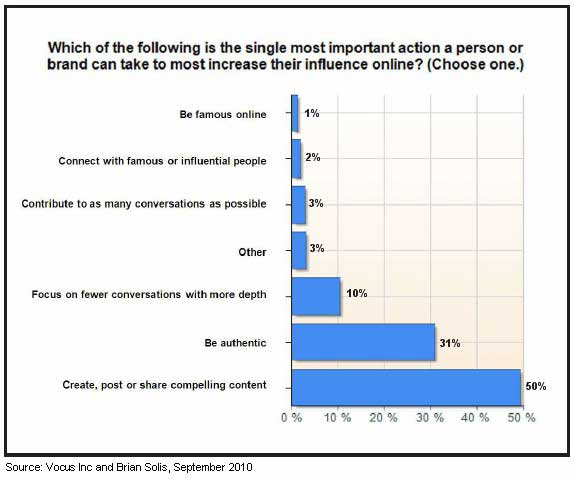
Fully one-half of surveyed marketing execs say creating, posting, and sharing compelling content is the single most important action people or brands can take to increase their influence online, followed by authenticity (31%), and depth of conversation (10%).
For additional charts and findings, see "Content Quality (Not Quantity) Builds Social Media Influence."
*All 10 articles were originally compiled and written by Lenna Garibian, research writer for MarketingProfs. Reach her via data@marketingprofs.com.




